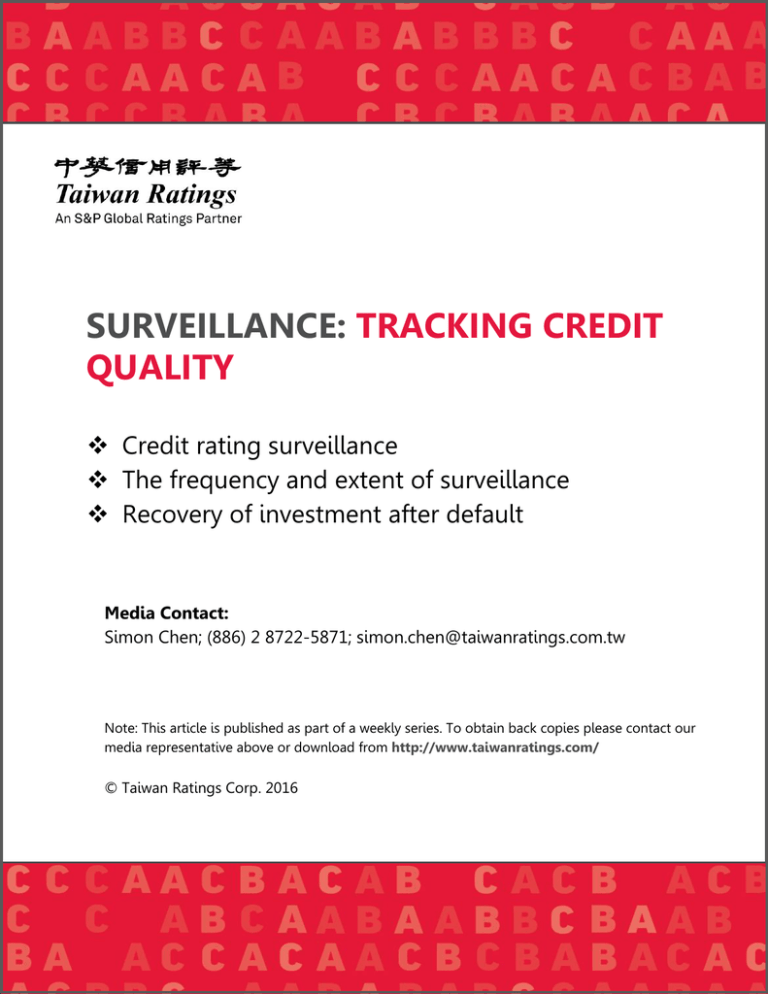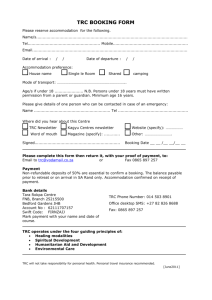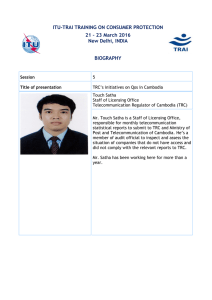
May 4, 2016
SURVEILLANCE: TRACKING CREDIT
QUALITY
Credit rating surveillance
The frequency and extent of surveillance
Recovery of investment after default
Media Contact:
Simon Chen; (886) 2 8722-5871; simon.chen@taiwanratings.com.tw
Note: This article is published as part of a weekly series. To obtain back copies please contact our
media representative above or download from http://www.taiwanratings.com/
© Taiwan Ratings Corp. 2016
Taiwan Ratings Corp. | 2016
1
May 4, 2016
SURVEILLANCE: TRACKING CREDIT
QUALITY
Credit Rating Surveillance
Agencies typically track developments that might affect the credit risk of an issuer or individual
debt issue for which an agency has provided a ratings opinion. In the case of Taiwan Ratings,
the goal of this surveillance is to keep the rating current by identifying issues that may result in
either an upgrade or a downgrade.
In conducting its surveillance, the rating agency may consider many factors, including, for
example, changes in the business climate or credit markets, new technology or competition that
may hurt an issuer’s earnings or projected revenues, issuer performance, and regulatory changes.
The Frequency And Extent Of Surveillance
The frequency and extent of surveillance typically depends on specific risk considerations for an
individual issuer or issue, or an entire group of rated entities or debt issues. In its surveillance of
a corporate issuer’s ratings, for example, Taiwan Ratings may schedule periodic meetings with a
company to allow management to:
Apprise agency analysts of any changes in the company’s plans.
Discuss new developments that may affect prior expectations of credit risk.
Identify and evaluate other factors or assumptions that may affect the agency’s opinion
of the issuer's creditworthiness.
As a result of its surveillance analysis, an agency may adjust the credit rating of an issuer or
issue to signify its view of a higher or lower level of relative credit risk.
Recovery Of Investment After Default
Credit rating agencies may also assess recovery, which is the likelihood that investors will
recoup the unpaid portion of their principal in the event of default (the failure to meet the legal
obligations or conditions of a loan). Some agencies incorporate recovery as a rating factor in
evaluating the credit quality of an issue, particularly in the case of non-investment grade debt.
Other agencies, such as Taiwan Ratings Corp.'s parent, S&P Global Ratings, issue recovery
ratings in addition to rating specific debt issues. S&P Global Ratings may also consider recovery
ratings in adjusting the credit rating of a debt issue up or down in relation to the credit rating
assigned to the issuer.
[Editor's note: The contents of this article are based on the publication "GUIDE TO CREDIT RATING
ESSENTIALS," published on http://www.spratings.com, Copyright © 2014 by S&P Global Ratings]
Taiwan Ratings Corp. | 2016
2
May 4, 2016
Copyright © 2016 by Taiwan Ratings Corporation (TRC). All rights reserved.
No content (including ratings, credit-related analyses and data, valuations, model, software or other application or output
therefrom) or any part thereof (Content) may be modified, reverse engineered, reproduced or distributed in any form by any
means, or stored in a database or retrieval system, without the prior written permission of TRC. The Content shall not be
used for any unlawful or unauthorized purposes. TRC and any third-party providers, as well as their directors, officers,
shareholders, employees or agents (collectively TRC Parties) do not guarantee the accuracy, completeness, timeliness or
availability of the Content. TRC Parties are not responsible for any errors or omissions (negligent or otherwise), regardless of
the cause, for the results obtained from the use of the Content, or for the security or maintenance of any data input by the
user. The Content is provided on an "as is" basis. TRC DISCLAIMS ANY AND ALL EXPRESS OR IMPLIED WARRANTIES,
INCLUDING, BUT NOT LIMITED TO, ANY WARRANTIES OF MERCHANTABILITY OR FITNESS FOR A PARTICULAR PURPOSE OR
USE, FREEDOM FROM BUGS, SOFTWARE ERRORS OR DEFECTS, THAT THE CONTENT'S FUNCTIONING WILL BE
UNINTERRUPTED OR THAT THE CONTENT WILL OPERATE WITH ANY SOFTWARE OR HARDWARE CONFIGURATION. In no
event shall TRC be liable to any party for any direct, indirect, incidental, exemplary, compensatory, punitive, special or
consequential damages, costs, expenses, legal fees, or losses (including, without limitation, lost income or lost profits and
opportunity costs or losses caused by negligence) in connection with any use of the Content even if advised of the
possibility of such damages.
Credit-related and other analyses, including ratings, and statements in the Content are statements of opinion as of the date
they are expressed and not statements of fact. TRC credit ratings are opinions about relative credit risk. TRC's opinions,
analyses and rating acknowledgment decisions (described below) are not recommendations to purchase, hold, or sell any
securities or to make any investment decisions, and do not address the suitability of any security. TRC assumes no obligation
to update the Content following publication in any form or format. The Content should not be relied on and is not a
substitute for the skill, judgment and experience of the user, its management, employees, advisors and/or clients when
making investment and other business decisions. TRC does not act as a fiduciary or an investment advisor except where
registered as such. While TRC has obtained information from sources it believes to be reliable, TRC does not perform an
audit and undertakes no duty of due diligence or independent verification of any information it receives. TRC cannot
guarantee the accuracy, completeness, or timeliness of the information relied on in connection with a rating or the results
obtained from the use of such information.
To the extent that regulatory authorities allow a rating agency to acknowledge in one jurisdiction a rating issued in another
jurisdiction for certain regulatory purposes, TRC reserves the right to assign, withdraw or suspend such acknowledgement at
any time and in its sole discretion. TRC disclaims any duty whatsoever arising out of the assignment, withdrawal or
suspension of an acknowledgment as well as any liability for any damage alleged to have been suffered on account thereof.
TRC keeps certain activities of its business units separate from each other in order to preserve the independence and
objectivity of their respective activities. As a result, certain business units of TRC may have information that is not available
to other TRC business units. TRC has established policies and procedures to maintain the confidentiality of certain nonpublic information received in connection with each analytical process.
TRC receives compensation for its solicited ratings and certain analyses, normally from issuers, originators, arrangers, or
underwriters of securities or from obligors. TRC reserves the right to disseminate its opinions and analyses. TRC’s public
ratings and analyses are made available on its Web sites, www.taiwanratings.com (free of charge), and
rrs.taiwanratings.com.tw (subscription), and may be distributed through other means, including via TRC publications and
third-party redistributors.
Taiwan Ratings Corp. | 2016
3





